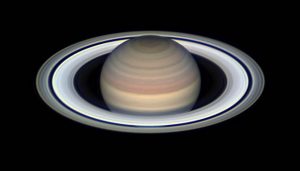
Saturn and its rings – image courtesy of Sky & Telescope & Chris Go
Saturn takes the cake, especially when it comes to those mesmerizing rings. The sixth planet from the sun and the second largest in our solar system, blitzes with rings made up of rocks, water and ice.
Saturn is a sight for sore eyes through a telescope, and is adored by many astronomers. The planet also offers observers rings that incline, change, and even sometimes vanish. Saturn is full of magic.
Saturn’s Orbit
Saturn is a superior planet, which means it orbits outside of the Earth’s orbit and does so much slower than our home planet. Saturn takes 29.5 Earth years to orbit around the sun. Because Saturn is a superior planet, sky watchers can be on the look out for oppositions and conjunctions.
The next big event for Saturn viewing will be when the planet is in conjunction with Mars. The pair will be closest to each other on August 25, 2016. Saturn will be directly above Mars and in the right leg of the constellation Ophiuchus, the serpent bearer (Greek).
Ending in November 2016, observers can still catch a glimpse of Saturn’s north side rings as they remain open and reveal an inclination of 26o. So if you would like to view Saturn, you have until November, then Saturn will fade away into the rays of the sun for it’s solar opposition, peaking on December 10, 2016.
What makes Saturn extra special for night sky viewers is that it’s the farthest planet seen by the naked eye. Sadly, Uranus and Neptune are too far for spying human eyes.
As Saturn orbit’s, the rings shift in inclinations by degrees from the Earth’s vantage point. When Saturn’s rings are mirroring the Earth, the rings go through what is called a “ring plane crossing”, thus creating the illusion that the rings have vanished.
Fortunately, Saturn only experiences two ring plane crossings an orbit, so about every 15 years. The last ring plane crossing was on September 4th, 2009 and the next one will be roughly close to 2024.
Saturn’s Rings
Saturn’s rings were first discovered by Galileo Galilee in 1610. Though Galileo did not have a sharp image of the rings, he recorded an observation of “extensions” to the planet and drew them like cup handles coming out from both sides of the planet. As Galileo filled his astronomy journal, it was discovered that these “extensions” changed over time, even disappearing (ring plane crossing). It wasn’t until later when astronomer, Christiaan Huygens, used a more advanced telescope to identify those extensions as rings.
Saturn’s rings are majestic, glimmering and violently powerful. The rings move fast and furious while circling the golden planet on average of 40,000 miles per hour. The inner rings travel faster and the outer rings slower and all rings travel at different speeds.
Spanning at 170,000 miles wide with a shockingly razor thin height of just 30 feet, (the height of a two story building), these rings are omnipotent. They speed through the racetrack around Saturn, carrying debris of comet pieces, water ice and other universal rock particles.
There are at least 12 rings around Saturn; however, there’s no definite count of rings as there’s much more still to discover. Generally, the rings of Saturn are named in order of discovery using an alphabetic system (A, B,…).
Saturn is not the only planet in our solar system that contains rings. Uranus, Jupiter and Neptune also have rings, though they are weaker and don’t reflect much light to captivate like the jewel of the solar system ~ Saturn.
It has been theorized that Saturn got its rings because of a moon crash; either a moon crashed into another moon or an asteroid hit one moon and that debris became part of the gravitational force of the planet.
Currently, Saturn’s F-ring is baffling scientist because of its dynamic characteristics. In fact, the F-ring is experiencing a very interesting phenomenon. Scientists have discovered a disturbance on the F-ring which has caused a bright spot. Currently the reason is a mystery but scientists are pondering whether it was the suspicious near by moon, Pandora, or an asteroid strike that may have caused it.
Spacecrafts and Saturn
To date, four spacecrafts have orbited by Saturn while capturing and recording photographic data. The first mission of Saturn was conducted by Pioneer 11 in 1979. Soon after in 1980, Voyager I and one year later, in 1981, Voyager II, also blasted by while computing precious data. These early year astronomical studies helped researchers discover more about Saturn’s moons. Last but certainly not least, the fourth and most neoteric mission to Saturn is controlled through the spacecraft Cassini.
Cassini has been on a mission to Saturn for almost ten years. On October 15, 1997, Cassini blasted off from Cape Canaveral with a destiny to reach and study Saturn. Cassini also boarded the Huygen’s probe, developed by the ESA, which is dedicated to the study of one of Saturn’s moon, Titan. The Huygen probe will capture photographic data of Titan and help scientists gather information on Titan’s rich atmospheric and geographic characteristics.
Titan is the largest of Saturn’s 62+ moons and the second largest moon in the solar system. Jupiter has the largest moon in our solar system, Ganymede and Earth’s moon is the fifth largest. Titan is the one natural satellite in our solar system that contains atmospheric conditions similar to that of Earth’s early years. If life in the solar system could be anywhere, it could very well be on Titan.
On July 1, 2004, Cassini became the first spacecraft to orbit the planet Saturn, the other’s just flew by. Cassini is discovering new data for scientists that is unlocking many mysteries of moons and planets.
In November of 2016, Cassini will probe close to Saturn’s F ring helping scientist get more data on the miraculous nature of one of Saturn’s most popular rings.
Conclusion
There is an array of discoveries that keep astronomer’s busy. Just exploring Saturn alone takes devotion because there’s so much to learn about the golden planet’s glory.
As Cassini continues to probe and capture the closest photos of Saturn ever taken, astronomers, scientists and everyone who is curious will learn more about the sixth planet from the sun.
By Donna Morgese – KPO staff writer

